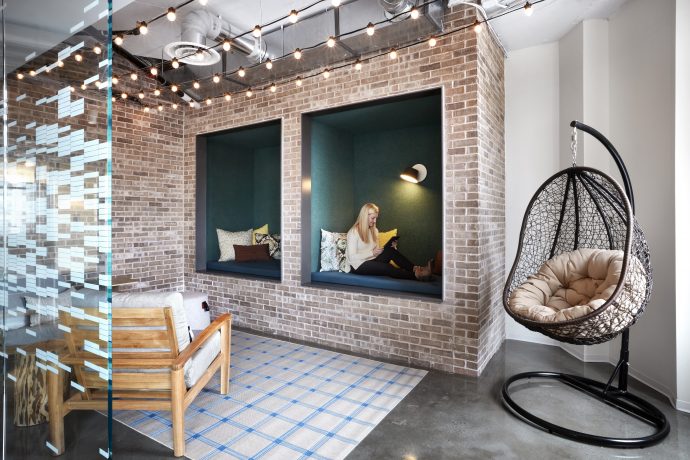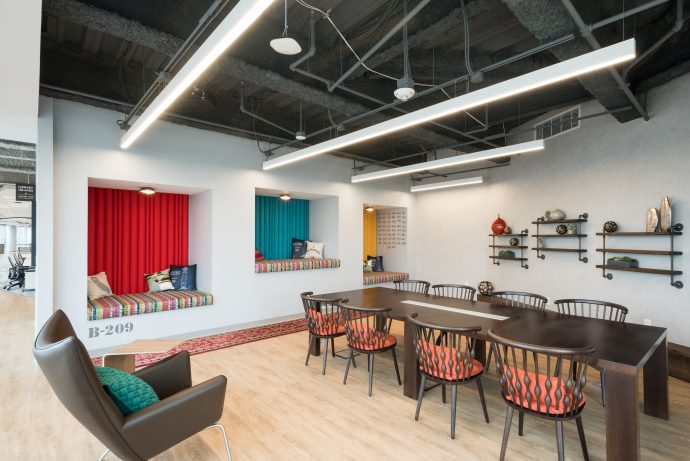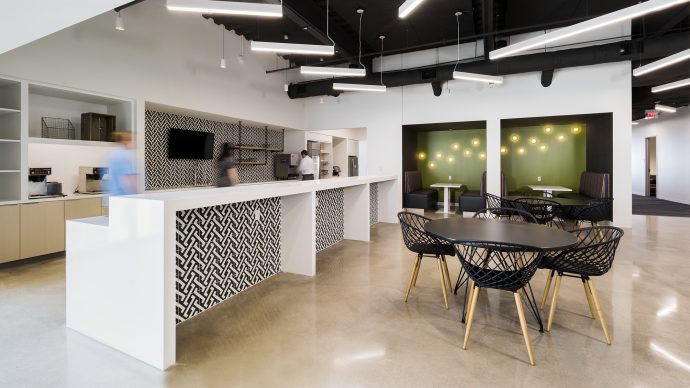WDM recently followed up with Capital One to check in on how they’ve used the 2017 Work Environment Study to implement better designs in their offices.

When the results of the Capital One 2017 Work Environment Survey were released, there was a considerable amount of media buzz. The story was picked up in almost all the industry related newsletters and much of the main stream media of interest to workplace design bloggers, and of course, Work Design Magazine. The press release shared the most relevant stats but given that we are all about workplace design, and are inherently curious, we wanted to find out more Capital One plans to work with the information to implement better workplace designs not only in their own portfolio but to broaden the discussion on what makes for a great place to work and how to provide the work environment to do so.
They must be doing something right, as Capital One consistently has been highly rated in best places to work surveys, from Fortune’s 100 Best list to multiple best workplace lists globally.
We were able to book some time with Capital One’s Stefanie Spurlin, vice president of workplace solutions, a team supports the company’s more than 40,000 associates so that they have the best work environment and employee experience. Stefanie kindly shared with us more about the survey and the resultant activities her team is working on based on the information gathered from the 2,500 participants. The results changed the thinking and direction of workplace design not only for Capital One, but other companies as they take notice of and re-think their approach to managing real estate portfolios and workplace planning and design efforts.
Work Design recently featured Capital One’s Chicago office, which was recently completed. The innovative and creative design solution article supports Capital One’s commitment to provide dynamic workspaces for their employees.
How did the report validate Capital One’s workplace design implementations?
The Work Environment Survey validated Capital One’s workplace design strategy in several important ways. First, it reinforced the importance of ongoing iteration. We continually get the pulse of our end users—our Capital One associates—and know that there are many sub-groups within that base that all deserve equal attention. Secondly, the insights around more desired features and design elements proved the importance of our partnerships with design firms who bring not only a depth of expertise, but a breadth of knowledge across markets and industries. We implement best practices as well as new concepts in a test-and-learn style. The biggest direct affirmation proved what we firmly believe at Capital One: workspaces and workplace experiences are an integral part of producing great work. The survey found that 82 percent of office professionals believe companies can’t encourage innovation without an innovative workplace design and environment.

How will the data inform any changes you may make to current planning endeavors?
We designed the survey to provide the maximum amount of information in a concise format so that we could extract insights for our own work as well as for the industry at large. We currently have several projects in motion and were excited to see the results confirm many of our decisions in those projects. As a data-driven company, we rely on a testing culture, always learning from earlier generations that we’ve introduced. As a company that is still founder-led, Capital One embraces an entrepreneurial mindset. That combined with our data-driven culture means that we are always looking for new insights to incorporate into our plans as we grow and evolve. We’re excited to conduct the survey again this year and gather year-over-year data and identify trends.
How have the results of the survey validated a design decision?
A major theme in the 2017 Work Environment Survey results was employees’ want for increased options in the workplace. Responses indicated a desire for easily reconfigurable spaces, collaborative spaces, and areas for rest and relaxation. That, couple with the continued prioritization of natural light and bold colors, validates parts of the strategy that we already have in place. The image below shows a more relaxed social space in our Tysons, Virginia headquarters that creates a space for informal meetings, group discussions, and comfortable reading. We embed spaces like this throughout our offices to provide the flexibility and relaxation that our associates need to collaborate and recharge.

What kind of results is Capital One seeing in its newer spaces that support the findings in the report?
While the survey results provided many interesting data points, the most exciting element for us what was the overall results: workplace design and environment positively impact the employee experience and contributes to their success. We’re excited to continue conducting the survey in addition to the many internal listening tools we already employ like surveys, focus groups, and team feedback sessions. We’re committed to incorporating internal and external feedback to impact the evolution of our workplace strategy.
I appreciate that our space has a lot of options. I have my desk, of course, but I also have access to open spaces for brainstorming with my team, movable furniture to adjust whenever we need to, quiet spaces when I need to get in the zone, and flexible spaces for anything from a celebration of our latest product release to a meetup with other developers in the local tech community. – Kaylyn Gibilterra, Senior Software Engineer, Capital One.
How else do you collect feedback?
We conduct pre- and post-occupancy surveys as well as observational studies. We also gather associate feedback through formal channels like our All Associate Survey and informal conversations by having open lines of communication across all our internal customers.
Was there anything that Capital One found in the survey that instigated a design change or something that was overwhelmingly received with positive feedback?
We saw that office professionals wanted more art and creative imagery in their workplaces. These results speak to the shift that’s taking place across the workforce. Employees expect organizations to strive towards a more innovative, creative, culture-infused environment that promotes balance while empowering workers to embrace their preferred method of working. One way that we support this is through our art program, which works with local artists and curates content directly from our local communities.

What has Capital One tried in its workplaces that did not work?
Like any strategy, there are always things that don’t work—but that shouldn’t stop you from continuing to try new things. We’re constantly iterating, constantly evolving— and we have a willingness and recognition that something may not work and that’s ok. We learn from those times and improve for the next phase. We always ask ourselves, “How can we learn from that and apply that to the next generation?”
What trends do you see evolving out of the changes you have made to your more traditional workspaces?
One of the bigger trends that we’re focusing on in our spaces is well-being. We’ve iterated on that concept a lot in recent years, expanding and redefining our workplace amenity strategy to include a more holistic and inclusive well-being approach. An important part of that process has been incorporating feedback from our associates, and last year the first Work Environment Survey results reinforced trends that we were already seeing internally like a prioritization of health and wellness programs and options in the workplace.




This was a great read. I love that the belief that they can’t encourage innovation without an innovative workspace. Capitol One seems to realize that if they want their employees to give their all, then the business needs to give a little something back to them. Creating a fun and inspiring place to work can really do wonders for employee productivity. Having a beautiful work environment encourages employees to give back that same level of inspiration. All in all, this was wonderful to read.
[…] https://workdesign.com/2018/07/following-up-capital-one-2017-work-environment-survey-findings […]
[…] quite a stir and was featured across all news platforms focused on workplace design, including Work Design Magazine. As the concept of work and where we work is rapidly evolving, we were interested in seeing how the […]